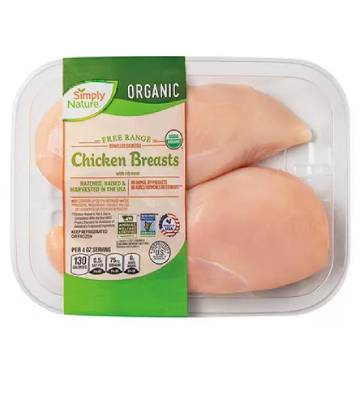Food Nutrition Facts
Nutrition Facts For
Chicken - Breast
Portion Size: 1 Breast
| Nutrient | Value | % Daily Value* |
|---|---|---|
| 140.0 kcal | 7% | |
| 3.0 g | 0% | |
| 0.0 g | 0% | |
| 80.0 mg | 27% | |
| 50 mg | 2% | |
| 72.0 mg | 2% | |
| 0.0 g | ||
| 0.0 g | ||
| 0.0 g | ||
| 0.0 g | ||
| 26.0 g | ||
| Chicken |
*Daily value based on a 2,000 calorie diet. Your daily values may be higher or lower depending on your calorie needs and health goals.
Calculate your daily calorie needs here
Nutrition Facts For 1 Breast of Chicken - Breast

A typical chicken breast is approximately 3 ounces.
Chicken breasts are a lean and versatile cut of poultry, prized for their mild flavor and ease of preparation. They are a popular choice for health-conscious individuals due to their high protein content and relatively low fat. Chicken breasts can be cooked in a multitude of ways, from grilling and baking to pan-frying and poaching, making them adaptable to a wide range of cuisines and culinary styles. Their neutral flavor profile allows them to readily absorb the flavors of marinades, sauces, and spices, making them a blank canvas for culinary creativity.
Beyond their nutritional value and versatility, chicken breasts are also a convenient and readily available protein source. They can be purchased boneless and skinless, further simplifying preparation. While often lauded for their health benefits, it's important to note that the way chicken breasts are prepared significantly impacts their nutritional content. Adding excessive amounts of oil or breading, for example, can increase the fat and calorie content. However, when cooked simply and paired with healthy sides, chicken breasts remain a nutritious and delicious option for a balanced diet.







